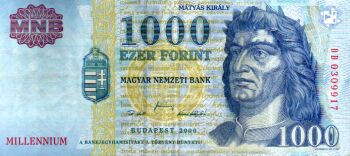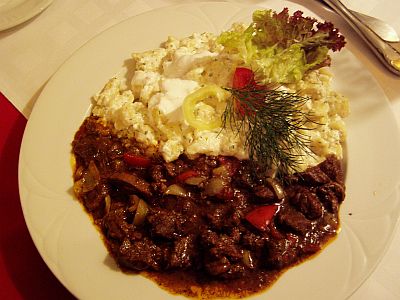Prologue
Many people will agree that Hungary is simply a must-see in Europe. Unfortunately, many visitors see little more than Budapest and Lake Balaton. Indeed - there are no real mountains and there's no coastline. On the other hand, the country offers highly interesting cultivated landscapes, many sights, excellent food (not to forget the drinks) and more. I've been to Hungary four times, but I can't get enough of it... By the way, my personal favourite in Hungary is definitely the old city of →Pécs.
Visa
Most nationalities do not require a visa. A valid passport is everything you need. A glorious exception is Australia - but rumours say that this might change in the near future. Usually, there's also no hassle at the border.
Money
The Hungarian currency is called Forint (abbr. ft). 1 ft = 100 Filler, but due to the low value, Filler are not in use any longer.

| ||
| Hungarian 1,000 Forint-Bill |
Recently, the currency is very stable thanks to a low inflation rate and a prospering economy. The average exchange rate is € 1 = 250 ft. The Hungarian currency is freely convertible, which means that changing money is no problem at all. It's also possible to exchange Forints at many exchange booths in neighbouring countries, although the exchange rate is worse outside the country.
There is no lack of ATM's in the cities, accepting common credit cards and Maestro, Cirrus (formerly EC) etc cash cards. The usual fee per transaction is € 4. Cash can be exchanged everywhere. Many hotels also accept Euro and USD.
There are 1, 2, 5, 10, 20, 50 and 100 ft coins and 200, 500, 1000, 2000, 5000 and 10,000 ft banknotes.
Costs
Hungary offers everything you can also find in Western Europe, but prices are substantially cheaper. It's no problem to find a bed for a night for € 10; eating out in restaurants is quite cheap as well. The same can be said about train and bus tickets. Costs for travelers can be compared to those of the →Czech Republic - which means that it's possible to get by on as little as € 20 a day, but it's no problem to spend much more - depending on the style of traveling. However, travelers coming from the neighbouring countries →Romania, →Serbia, not to talk about the →Ukraine, will soon complain about the high prices in Hungary. It goes without saying that Budapest and the area around Lake Balaton are much more expensive than the rest of the country.
Transportation inside the country is comparatively cheap, but international trains can be really expensive. There's a weird discount system - return tickets for trains are often cheaper than a single ticket. It's definitely a good idea to check for discounts (student, return etc) before purchasing long-distance train tickets.
Getting there
You can get to Hungary by bus, train, plane, car or by boat. Yes, boat. And - except for the Ukraine - most nationalities (sorry Aussies) do not require a visa for the neighbouring countries, so it's easy to move in and out freely. There are direct flights to Hungary from every major European city. The national carrier is called Malev, but many other airlines operate flights to and from Hungary as well. Since Hungary is not a very big country and Budapest lies in the centre of it, almost all flights go to Budapest.
There are many international bus connections from Middle Europe to Hungary. Many of those buses go ahead to →Serbia, →Romania, →Bulgaria and even as far as →Turkey. Of course buses are not the most convenient way to get there.
The connection with the European railway network is excellent. Many international trains go to or pass Budapest. Note that there are three important train stations in Budapest - Keleti pu. (East terminal), Nyugati pu. (West terminal) and Déli pu. (South terminal) - "pu." stands for Pályaudvar (train station). Hence, it's a good idea to read timetables carefully to understand, where the trains are running to or starting from. Anyway, all three train stations are conveniently accessible by the subway.
- There are direct trains from Budapest to →Kiev (24 hrs) in the →Ukraine via →L'viv (Lvov) (15 hrs).
- There are several daily trains to neighbouring →Slovakia, most of them running to Bratislava (2½ hrs) but also to →Košice in the east.
- Of course there are also many trains to the →Czech Republic. Most of them run to or via →Prague (less than 7 hrs). Some of them continue via Dresden(10 hrs) to Berlin (12 hrs). When coming from Germany, it's a good idea to ask for the so-called SparNight-Tarif. The return ticket from a city of your choice in Germany in a comfortable sleeping car can be as cheap as € 98. There's only one disadvantage - the ticket must be bought several weeks in advance and it's not possible to change the departure time.
- Direct trains run westwards to →Slovenia, most of them to the capital →Ljubljana (more than 8 hrs, the return ticket costs € 45, the single ticket € 60 - yes, that's ridiculous). One of those trains continues to →Trieste and Venice.
- There are also direct trains to →Bucharest and →Brasov in →Romania - the trip to Brasov takes appr. 12 hrs, to Bucharest 15½ hrs. There's one carriage going as far as →Varna in →Bulgaria, but I guess that's only in summer.
- Some daily trains run to →Serbia, especially to →Novi Sad (6 hrs, return ticket around € 30) and →Belgrade (7½ hrs)
- There's good news: Train service to →Sarajevo has been resumed in 2003. The trip to Sarajevo takes around 12 hours. There are also some direct trains to →Zagreb in →Croatia (5 hrs).
- Another international train connects Budapest with →Warsaw, which takes around 11 hours.
- Last but not least Vienna, which is not very far away. There are many daily trains running between Budapest and Vienna. A more elegant option is the boat. Daily boats run up the river Danube to Vienna via Bratislava. This takes around 6 hrs, but it's much more expensive than the train.
Border crossings
Hungary shares borders with Austria, →Romania, →Serbia, →Croatia, →Slovenia, the →Ukraine and →→Slovakia. Which means that there are border crossings everywhere. All of them are open to foreigners as well. Be aware of visa regulations for the Ukraine.
Food and drinks
Hungarian food is mostly very delicious and comes in generous helpings. Mainly used ingredients include bell pepper, red peppers, beef, pork, but also duck, chicken, sour cream, cheese and so on. As far as I have experienced, it doesn't really matter what you order - you won't be disappointed. Sometimes there's no other way then to just point at an item on the menu without knowing what it is - who understands dishes like Baconbe göngyölt csirkemell roston, párolt zöldségekkel? (Yes, it includes bacon. And a chicken steak, And broccoli, corn, carrots etc). Of course, good restaurants in Budapest and other bigger cities have English and/or German menus as well.

| ||
| Game stew, selfmade noodles and goat's cheese |
A great, but somewhat smelly treat is called Langos - flat, fried corn meal dough, topped with fresh garlic, sour cream and grated cheese. It's just a snack (although filling), so you won't find it in restaurants but only at food stalls. Probably the most famous Hungarian dish is called Gulyás (goulash, hot beef stew). Another famous one is the Halászlé (fish broth) and many others.
Hungary is quite famous for its wine production. Probably the most famous wine is the unique, rich Tokaj wine, which comes in many versions. Of course, Hungary also produces beer, for example Dreher or Köbanyai. The most common firewater is called Pálinka - some sort of brandy, made of various types of fruits. Some of them are really tasty. Hungary is also famous for herb-flavoured liquors. The most famous one is the Unikum, which can be found in many bars abroad as well.
©2024 Europe-East.com

 Albania
Albania Hungary
Hungary